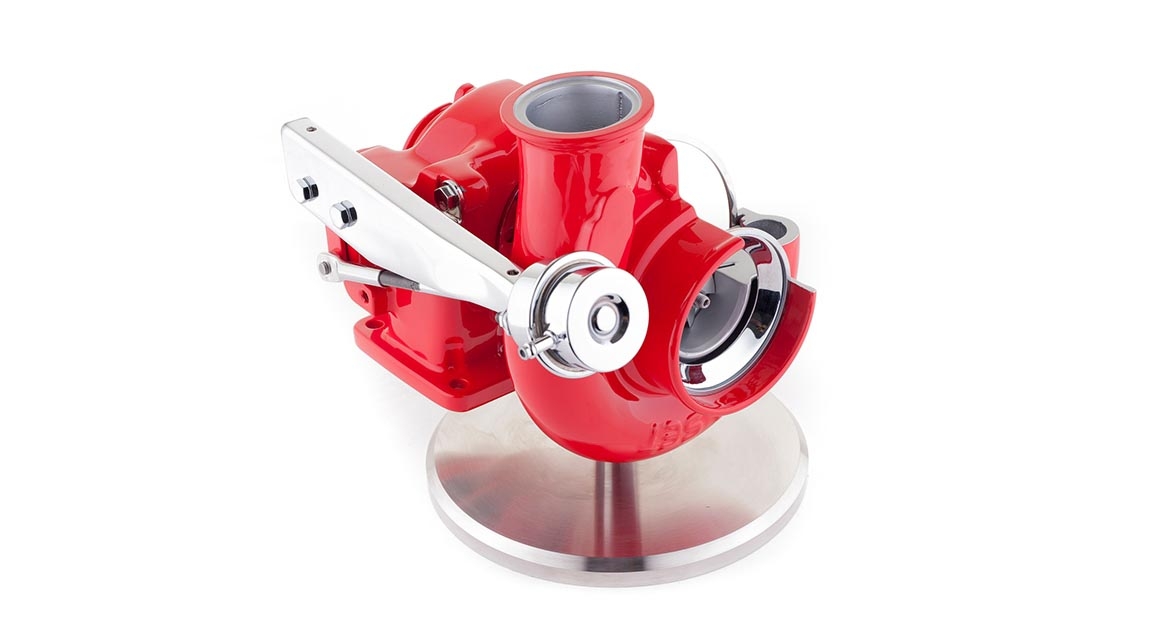How Are Turbochargers for Natural Gas Different From Those for Diesel Engines?
Cummins has detailed the evolution and key differences between turbochargers for natural gas and diesel engines. Natural gas turbochargers have undergone significant changes over the past decade, driven by emissions regulations and the adoption of stoichiometric burning. Modern natural gas turbochargers feature distinct components including dual wastegate ports, larger actuators (T4 vs T2), and specialized housing materials to handle higher temperatures exceeding 760°C.
Unlike diesel engines that operate with a lean burn, natural gas engines require a precise 1:1 air-to-fuel ratio, resulting in smaller turbochargers. The shift to stoichiometric burning has reduced the need for complex aftertreatment systems, lowering overall engine and turbo costs while meeting strict emissions standards.
Cummins ha dettagliato l'evoluzione e le principali differenze tra i turbocompressori per motori a gas naturale e diesel. I turbocompressori a gas naturale hanno subito cambiamenti significativi nell'ultimo decennio, spinti dalle normative sulle emissioni e dall'adozione della combustione stechiometrica. I turbocompressori moderni a gas naturale presentano componenti distinti tra cui porte per wastegate duali, attuatori più grandi (T4 vs T2) e materiali specializzati per l'alloggiamento in grado di gestire temperature superiori a 760°C.
Contrariamente ai motori diesel che operano con una combustione magra, i motori a gas naturale richiedono un rapporto aria-carburante preciso di 1:1, il che porta a turbocompressori più piccoli. Il passaggio alla combustione stechiometrica ha ridotto la necessità di sistemi complessi di post-trattamento, abbassando i costi complessivi del motore e del turbocompressore, rispettando al contempo rigorosi standard sulle emissioni.
Cummins ha detallado la evolución y las principales diferencias entre los turbocompresores para motores de gas natural y diésel. Los turbocompresores de gas natural han experimentado cambios significativos en la última década, impulsados por las regulaciones de emisiones y la adopción de la combustión estequiométrica. Los turbocompresores modernos de gas natural cuentan con componentes distintos que incluyen puertos de wastegate duales, actuadores más grandes (T4 vs T2) y materiales especializados para la carcasa que pueden manejar temperaturas superiores a 760 °C.
A diferencia de los motores diésel que operan con una combustión pobre, los motores de gas natural requieren una relación aire-combustible precisa de 1:1, lo que resulta en turbocompresores más pequeños. El cambio hacia la combustión estequiométrica ha reducido la necesidad de sistemas complejos de tratamiento posterior, disminuyendo los costos generales del motor y del turbocompresor, al mismo tiempo que se cumplen estrictas normas de emisiones.
Cummins는 가스 엔진과 디젤 엔진용 터보차저의 발전 및 주요 차이점을 상세하게 설명했습니다. 가스 터보차저는 지난 10년간 배출 규제와 스토이키오메트릭 연소의 채택에 의해 중요한 변화를 겪었습니다. 현대의 가스 터보차저는 독특한 구성 요소를 특징으로 하며, 여기에는 이중 웨이스트 게이트 포트, 더 큰 액추에이터(T4 대 T2) 및 760°C 이상의 고온을 견딜 수 있는 특수 하우징 재료가 포함됩니다.
디젤 엔진이 희박 연소로 작동하는 것과 달리, 가스 엔진은 1:1의 정확한 공기-연료 비율이 필요하므로 더 작은 터보차저가 필요합니다. 스토이키오메트릭 연소로의 전환은 복잡한 후처리 시스템의 필요성을 줄여 전체 엔진 및 터보 비용을 낮추면서도 엄격한 배출 기준을 충족합니다.
Cummins a détaillé l'évolution et les principales différences entre les turbocompresseurs pour moteurs à gaz naturel et diesel. Les turbocompresseurs à gaz naturel ont connu des changements significatifs au cours de la dernière décennie, motivés par les réglementations sur les émissions et l'adoption de la combustion stœchiométrique. Les turbocompresseurs modernes à gaz naturel sont dotés de composants distincts, y compris des ports de wastegate doubles, des actionneurs plus grands (T4 contre T2) et des matériaux de logement spécialisés capables de supporter des températures dépassant 760 °C.
Contrairement aux moteurs diesel qui fonctionnent avec une combustion pauvre, les moteurs à gaz naturel nécessitent un rapport air-carburant précis de 1:1, ce qui entraîne des turbocompresseurs plus petits. Le passage à la combustion stœchiométrique a réduit le besoin de systèmes de post-traitement complexes, abaissant le coût global des moteurs et des turbocompresseurs tout en respectant des normes d'émission strictes.
Cummins hat die Entwicklung und die wesentlichen Unterschiede zwischen Turboladern für Erdgas- und Dieselmotoren detailliert beschrieben. Erdgas-Turbolader haben im letzten Jahrzehnt erhebliche Veränderungen erfahren, die durch Emissionsvorschriften und die Einführung der stöchiometrischen Verbrennung vorangetrieben wurden. Moderne Erdgas-Turbolader verfügen über besondere Komponenten, darunter doppelte Wastegate-Ports, größere Aktuatoren (T4 vs. T2) und spezielle Gehäusematerialien, die Temperaturen über 760 °C standhalten können.
Im Gegensatz zu Dieselmotoren, die mit einer mageren Verbrennung arbeiten, benötigen Erdgas-Motoren ein präzises Verhältnis von 1:1 zwischen Luft und Kraftstoff, was zu kleineren Turboladern führt. Der Wechsel zur stöchiometrischen Verbrennung hat die Notwendigkeit komplexer Nachbehandlungssysteme verringert, wodurch die Gesamtkosten für Motor und Turbolader gesenkt wurden, während strenge Emissionsstandards eingehalten werden.
- Reduced need for aftertreatment systems (DOCs, SCR) leading to lower engine and turbo costs
- Improved environmental performance through stoichiometric burning technology
- Enhanced cost-effectiveness in natural gas engine systems
- Higher operating temperatures requiring more expensive materials and cooling systems
- More complex components needed (larger actuators, dual wastegate ports)
- Additional piping and connections required for water-cooled bearing housings
Insights
The technical advancements in natural gas turbocharger design represent an important evolution in Cummins' product portfolio, but this article primarily describes technical specifications without immediate financial or market implications. While the technology demonstrates Cummins' innovation in alternative fuel solutions, the content is educational rather than market-moving.
The discussion of stoichiometric burning and specialized components like dual wastegate ports and larger actuators shows technical progress, but lacks specific financial metrics, new product launches, or material business impacts. This appears to be a routine technical update rather than an announcement that would significantly affect CMI's stock price or market position.
NORTHAMPTON, MA / ACCESSWIRE / December 4, 2024 / Cummins Inc.
by Cummins Components Business Unit
Key Takeaways:
Turbochargers for natural gas engines have evolved significantly, driven by stringent emissions regulations and the adoption of stoichiometric burning.
Modern natural gas turbochargers feature distinct components compared to their diesel counterparts.
Cummins' innovations in natural gas turbocharger design have improved the cost-effectiveness and environmental performance of natural gas engines.
A decade ago, turbochargers for natural gas and diesel engines were not very different. However, new emissions regulations have driven the development of turbochargers specifically designed for natural gas engines. These turbochargers are adapted to stoichiometric burn conditions, where the mix of oxygen and fuel is precisely balanced. This balance ensures efficient combustion, leaving no unburnt fuel or excess oxygen.
Turbochargers developed for modern natural gas engines, have unique components like a dual wastegate port, larger actuators and a material housing made of composite materials that can withstand the higher temperatures a stoichiometric burn requires.
Cummins has spent decades developing innovative solutions for diesel and natural gas engines. This article explores how different turbocharger technologies are used for natural gas vehicles and how they have evolved to meet the challenges and demands of a transportation industry seeking more sustainable solutions.
Key differences between turbochargers for natural gas and diesel engines
Turbochargers for natural gas engines are distinct from those used in diesel engines due to the unique demands of natural gas combustion like higher operating temperatures and distinct air-to-fuel ratios. Unlike diesel engines, which operate with a lean burn and a higher air-to-fuel ratio, natural gas engines require a stoichiometric burn. This means the mixture of oxygen and fuel is balanced precisely (1:1 air-to-fuel ratio) for efficient combustion, ensuring no unburnt fuel or excess oxygen remains. Consequently, natural gas engines require smaller turbochargers since less air is needed for stoichiometric combustion compared to the leaner burn in diesel engines. For example, a diesel engine might need an HE500 turbo, but a natural gas engine could use an HE300 or HE400 due to its lower air requirements.
Achieving this efficient combustion has led to significant modifications in many system components, including the incorporation of a dual wastegate port to handle the high bypass capability necessary for natural gas turbochargers. This port regulates exhaust flow, controls pressure and prevents over-boost.
The intense temperatures and pressures of natural gas engines also influence turbocharger design. While diesel engines prioritize turbocharger efficiency, natural gas engines focus on achieving the required mass flow rate and meeting exhaust gas recirculation (EGR) demands. As a result, turbochargers for natural gas engines are built with high-temperature materials, particularly at the turbine stage, to resist thermal fatigue.
These turbochargers also require water-cooled bearing housings to manage the elevated temperatures, necessitating additional piping and connections to maintain coolant flow.
Housing Materials:
Cummins employs advanced materials in turbocharger construction to withstand the high temperatures of stoichiometric combustion in natural gas engines. These materials include graphite and stainless steel for the turbine housing, as well as higher-grade alloys like Chrome-Moly, which contains chromium and molybdenum. These materials allow the turbochargers to endure turbine inlet temperatures exceeding 760°C, far surpassing the operating temperatures of diesel engine turbochargers, which typically remain below 700°C.
Actuators:
Turbochargers for natural gas engines use larger actuators compared to those in diesel engines. A natural gas turbocharger uses a T4 actuator, which is 4 square inches, while a diesel engine turbocharger only requires a T2 actuator, a 2-square-inch component. This increase in actuator size is essential for managing the higher bypass capabilities and temperature demands of natural gas engines.
Modifications from diesel engines:
While natural gas engines share many components with their diesel counterparts, key modifications have been made to turbochargers to accommodate the use of gaseous fuel. These changes address the higher temperatures and different flow characteristics unique to natural gas, ensuring optimal performance and durability.
The evolution of the natural gas turbocharger
A decade ago, natural gas and diesel turbos were nearly identical, but stringent emissions regulations like
By shifting to stoichiometric burning, Cummins was able to reduce the need for aftertreatment systems like Diesel Oxidation Catalysts (DOCs) or Selective Catalytic Reduction (SCR) systems, which ultimately lowered the cost of the engines and turbos.
As a leader in turbocharger innovation and technology, Cummins is committed to working with customers to provide the right solutions for their applications. With Natural Gas being a critical player in decarbonizing commercial transportation, Cummins continues to optimize natural gas engine design, improve the economics of the engine systems while meeting strict emissions standards and make natural gas a competitive alternative to diesel in many applications.

View additional multimedia and more ESG storytelling from Cummins Inc. on 3blmedia.com.
Contact Info:
Spokesperson: Cummins Inc.
Website: https://www.3blmedia.com/profiles/cummins-inc
Email: info@3blmedia.com
SOURCE: Cummins Inc.
View the original press release on accesswire.com






